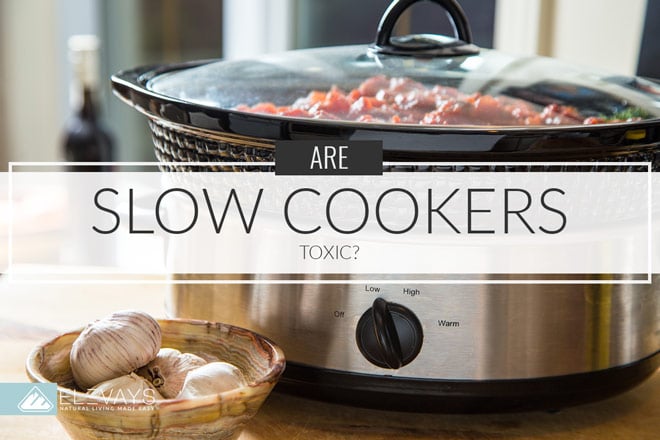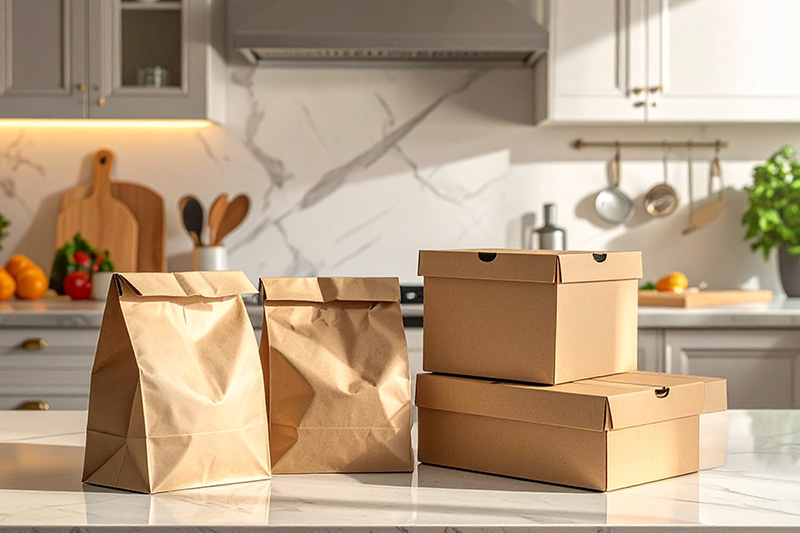You want to raise your kids in a non-toxic home, setting them up for future health and success, but you may not realize how toxic everyday household items are. Slow cookers or crockpots, for example, are a vital health concern found in many modern kitchens. The big question is, are slow cookers safe? Let’s find out.
With fall here, kids are back in school, sports are in full swing, and your work-life picks up again. Busy days lead to busy nights, and it’s so tempting to throw together a crockpot meal for an easy family dinner ready, right when you get home. They make cooking convenient and healthy. Thanks to the sealed chamber, slow cooking your food is an excellent way to retain the nutrients in your meals. However, are slow cookers safe?
In this article, I want to explore the kitchen toxins lurking in your home, what health concerns they come with, and how (or if) unfavorable toxins can be avoided. We’ll start by talking about what slow cookers are commonly made from, and you may be surprised at the toxins your slow cooker leaches into your food.
TRUTH BOMB:
You’re
Already killing it!
If You Were More Consistent With Your Wellness Routine, You’d Be Unstoppable.
Can Slow Cookers Be Harmful to Your Health?
Are slow cookers toxic? The answer is yes, sometimes.
It all depends on your appliance and the foods you cook. Learning whether or not your slow cooker is harmful to your health may depend on where and what type of appliance you have. The wrong slow cooker can harm your family’s health, unfortunately.
In 2004, a TV station looked at the amount of lead in kitchen tools where they found 20% of slow cookers leach lead into the food (6). They say the levels were below FDA standards, but even small amounts can add up and cause damage.
Although you may not notice any adverse symptoms immediately, like with food poisoning, toxic chemicals can take time to rear their ugly heads.
Toxic Materials
Some crockpots are made using toxic heavy metal, which includes natural metals in our environment that can get into the human body to interfere with normal functions. These toxins obviously end up in the food you cook. When it comes to slow cookers, the primary heavy metals to watch out for are lead and cadmium. They’re two of the four metals most extensively studied and known to cause adverse effects (10).
However, there are other toxins in the materials used to make everyday kitchen appliances too.
Toxins Found in Slow Cookers
The main toxins found in slow cookers include:
- Lead
- Cadmium
- Aluminum
- Mercury
- Arsenic
They can hide in the glaze coating ceramic, non-stick coatings, plastic pieces, and paints used to make slow cookers.
Lead is a neurotoxin heavy metal and is sometimes used in the glaze coating ceramic crockpots before they’re baked in the kiln. Although most high temperatures burn out the toxins, the ceramic can absorb the lead and add it to your weeknight dinners.
And this isn’t an ingredient you want to consume. Lead appears in the blood and affects each organ in the body. There’s no safe exposure level, and it’s more harmful to children than most chemicals. Kids should have a blood level with drastically reduced lead (and other chemicals).
Cadmium is another toxin in the glaze of ceramic wear. Although this heavy metal is less common in 20th-century products, food is the most likely source of cadmium exposure for non-smokers (10). The worst effect of long-term exposure to cadmium is full-blown kidney damage, but you may also see an increase in bone fractures and other issues (10).
Some people also want to try lining the crockpot with plastic or tin foil to make the cleaning process easier later. However, aluminum is another heavy metal that causes harm when you ingest it. High levels of exposure can cause anemia and other serious health issues in the:
- Lungs
- Bones
- Brain
- The nervous system (11)
Mercury, commonly found in seafood, may also reach other foods in your slow cooker in specific recipes. Studies link mercury exposure health risks, especially to kids and pregnant or nursing mothers, as adults tend to fall under low-risk (10).
In some locations, arsenic can be found in drinking water. Arsenic increases your risk of skin and other forms of cancer (10).
Health Risks Associated with Slow Cookers
There are many health risks of slow cookers, mainly due to lead.
Lead is highly toxic, even in small amounts. The Environmental Working Group marks lead as a 10/10 in terms of toxicity, with strong health concerns for human reproductive and developmental issues as well as cancer (1). The poisonous effects are worse for children, who absorb more toxins and nutrients in proportion to their body weight than adults.
A single serving of food made with toxic cookware won’t immediately kill you, but small amounts of the toxin can build up and become lead poisoning, which then causes an array of neurological issues. In kids, lead poisoning is linked to learning disabilities, lower IQ scores, and developmental delays (2).
Lead is also highly challenging to remove from the body once it’s there. While you can detox for heavy metals to help balance your body from lead exposure, the best way to prevent health risks is to avoid lead altogether.
The worst part is that there’s no way to know for sure if you have lead poisoning. It often comes with no apparent symptoms until months or years later. Small amounts can even cause serious health issues. You probably won’t know if you have lead poisoning until the toxins build up in your body, and the blood reaches dangerous levels. At extremely high levels, lead poisoning is fatal (3).
Newborns, kids, and adults all show lead poisoning in different ways. Adults and newborns may show reproductive-related problems, which for adults means reduced sperm counts, miscarriage, stillbirths, and issues with memory. Babies may be born prematurely, grow slowly, or have a low birth weight. Adults and kids may feel irritable, tired, sluggish, and have headaches or abdominal pain (3).
However, children tend to experience the most severe symptoms like:
- Developmental delay
- Learning issues
- Eating inedible objects
- A loss of appetite
- Constipation
- Vomiting
- Hearing loss
- Seizures
If you, regardless of age, feel weak and experience abdominal discomfort, you might suffer from lead poisoning. Without care, it could lead to worse symptoms such as vomiting, diarrhea, and constipation. Kids may show behavioral issues, learning disabilities, and cognitive development in the early stages. Then, the problem gets worse. From there, people can experience hallucinations, seizures, coma, and possibly even death.
Possible Health Risks of Slow Cookers
There is also limited evidence that lead is a probable human carcinogen toxic to the blood, kidneys, gastrointestinal tract, liver, respiratory system, and sense organs. It is possible lead exposure can even lead to (1):
- Immune system issues
- Allergies
- Weight resistance
- Skin issues like Psoriasis
- Endocrine disruption
Depending on where you live, you may also increase your blood lead level by using tap water. If you use unfiltered tap water to clean your vegetables prior to cooking in a slow cooker, which releases the moisture from the foods and confines the steam inside for hours, you may increase health risks. Common offenders in tap water include:
- Fluoride – A neurotoxin that alters thyroid hormones.
- Chlorine – Studies link chlorine to bladder and colorectal cancers.
- Heavy metals – There are 50 toxic heavy metals and 12 highly toxic ones, all of which research shoes lurk in public drinking water (10).
- Volatile organic compounds – Chemicals that irritate the nose, eyes, and throat as well as headaches, nausea, fatigue, dizziness, shortness of breath, skin issues, and damage to the liver and kidneys (9).
- Other chemicals – Mostly chemicals known to disrupt the endocrine system.
- Lead – Most older plumbing infrastructures use lead piping, which can leach lead into drinking water and adversely affect liver function and fertility.
Other Health Concerns of Slow Cookers
Another huge issue with using slow cookers are the liners designed to make cleanup fast and straightforward. Although they’re highly convenient for storing leftovers and cleanup, crockpot liners contain harmful plastics (BPA, BPS, or TPP) that are nearly as dangerous.
Some states, like Minnesota, have banned any products with harmful BPA plastic. However, the FDA has not yet spoken about health warnings associated with these liners in the U.S. You may still see liners with “FDA Approved” on the label to help consumers feel safe, but depending on where you live and buy the liner, it might not be entirely safe.
Most crockpot liners are made from a heat-resistant nylon resin, which studies show contain chemicals like:
- Cyclopentanone
- 2-cyclopentyl cyclopentanone
- Octadecane
- Heptadecane
All plastic containers are dangerous, but the main problem with crockpot liners is the heat. Heating up the material makes your body more likely to absorb the toxins through your food, and high temperatures allow the appliance to release more toxins in a shorter amount of time.
Hot temperatures also release more toxins. When the ceramic heats to around 78 degrees F, the appliance begins to release ten times the amount of lead than you may see when it’s at room temperature (6). Slow cookers reach temperatures much hotter than this, and over a prolonged time.
By heating the plastic for 6 to 8 hours or so, you’re only cooking the chemicals deeper into your food. Nylon resin, like plastic, contains chemical components that affect all food that comes in contact with the material. Fatty foods are especially likely to absorb more chemicals than other foods, however (4).
As with all high temperatures, you’re also likely to burn the plastic and cause injuries. The American Burn Association says burns are likely to happen when you lift a crockpot liner filled with food, as the material tears easily. You could also tear the liner with a fork or knife, or spatter the hot liquid as you spoon it out (5).
So, are slow cooker liners safe? No, as they’re typically plastic, nylon, or aluminum.
Can You Avoid Heavy Metals in Slow Cookers?
There are some steps you must take to avoid heavy metals in your appliance.
How to Determine if Your Slow Cooker Contains Lead
If your slow cooker doesn’t include information on the materials used to create the appliance, it may have lead. Heavy metals like lead are often found in the glaze coating the ceramic pieces. It’s safer to assume at least a little lead is in anything not clearly marked, but products often aren’t marked “lead-free.”
You can test for lead at home with a testing swab. They cost around $3 per stick from most locations, and are easy enough for beginners to use alone. Use them to test any surface in your home, from slow cookers and other kitchen appliances to wood or drywall. If the swab turns red, you have lead. However, it’s crucial to remember that lead levels change as the appliance heats, so your reading may not be wholly accurate. Your lead test’s reading still doesn’t fully guarantee safety from the chemicals leaching into your food.
Ways to Avoid Lead Exposure From a Slow Cooker
The best way to avoid heavy metals from a slow cooker is to avoid lead exposure completely. It’s perhaps the most dangerous toxin found in our everyday lives.
Avoid Lead Slow Cookers
Look for a crockpot with lead-free glaze and some sort of proof to back up the claim. Even if the slow cooker claims to meet the FDA’s requirements, it may not accurately explain the severity of your exposure to lead.
Keep in mind where you buy your crockpot as well. Products made in China, especially crockpots, are much more likely to use lead glaze in cooking items because the country has fewer regulations on chemical contamination.
Likewise, some states have stricter laws on warning labels and toxin ingredients. California’s Prop 65, for example, calls for warning labels on products with much lower amounts of lead and other harmful chemicals than the FDA requires. This means a slow cooker that can pass Prop 65 leaches less than 1 milliliter of led (7), which is a much safer way to know the amount of lead than FDA mandates right now. Look for Prop 65 labels for safer slow cookers, particularly if you live or buy appliances from California.
Or, it may be safer if you pony up a little more money for a ceramic-free slow cooker. Clay, glass, cast iron, or stainless steel slow cookers are the best options. People in ancient times used clay dishes and cookware, and unglazed clay slow cookers are available that bring out the natural flavors and preserve the food’s nutrients.
You could also buy a slow cooker with glass insert. Glass, for example, comes with no risk of lead exposure and is a great alternative material for glazed ceramic.
Cuisinart claims all their options are lead-free slow cooker 2019 products, while VitaClay makes an excellent organic clay crockpot that’s 99.99% lead-free. The double-lid design VitaClay offers makes it my favorite non-toxic slow cooker because it cooks the food faster and saves energy compared to regular options on the market today.
Avoid Acidic and Fatty Foods
Another way to avoid lead exposure from a slow cooker is to never cook food or drinks with lots of acid or fat. Acidic foods contain a pH balance of below 4.6 (where 7 is neutral) and absorb lead faster, so avoid citrus fruits (8). Avoid highly acidic ingredients like the most common choices:
- Vinegar
- Tomatoes
- Lemons
- Limes
- Grapes
- Plums
- Apples
- Oranges
- Sugar
- Grains
- Fish
- Dairy products
- Processed foods
- High-protein foods
Fatty foods also absorb chemicals from the liner faster because they increase the temperature of the appliance, and you can combat this by cutting off any extra fat from meat or avoiding them in your crockpot meals altogether.
Balance Acidity and Fatty Foods with Veggies
Instead, incorporate plenty of fresh vegetables. They’re not typically acidic. Use more neutral pH levels to balance the acidity levels in your food through:
- Cabbage
- Beets
- Mushrooms
- Corn
- Broccoli
- Collard greens
- Potatoes
- Beans
- Lentils
- Whole grains, like quinoa
- Healthy fats, like olive or avocado oil
You should also keep food safe by avoiding red kidney beans, as they contain natural toxins that grow when cooked at low temperatures like a slow cooker. However, no food is safe from lead exposure in a slow cooker with ceramic glaze.
Avoid Using 1970s Crockpots
If you have an old or hand-me-down slow cooker, throw it out. Slow cookers became widely popular in the 1970s due to their convenience. Since they’re making a huge comeback among today’s middle-class families, you may see plenty of appliances from the 70s still in decent working condition. Your mother may even try to hand off her old appliance for your family to use, but don’t be tempted. Old-style slow cookers contain higher amounts of lead than even modern counterparts.
Clean Cookware by Hand
Cleaning your crockpot by hand is also helpful, as the dishwasher can crack the glaze coating your ceramic bowl and allow more lead to seep out.
Eat Foods To Naturally Detox
Another way to reduce your family’s exposure to heavy metals is to naturally detoxify with foods. Increase the number of chelating foods that boost your body’s natural production of glutathione to help detox, such as:
- Cruciferous veggies
- Cilantro
- Garlic
- Whey protein
- Turmeric
- Gelatin
Bone broth also shows promising results in cleansing the body. Use your new lead-free slow cooker to try a bone broth diet, which comes with tons of health benefits like:
- Increased energy
- Better digestion
- Increased nutrient absorption
- Rejuvenated skin and bones
- Fewer hunger cravings
- Decrease in allergies
- Reduced inflammation and pain
- Aid with skin issues, arthritis, and infectious disease
- Faster recovery from illness or surgery
- Recovery from autoimmune and digestive disorders
Cook Slowly at Low Temperatures
Because lead toxicity leaches out more with higher temperatures, try keeping the slow cooker programmed on low. Temperatures between 170-280 degrees F are ideal for cooking over several hours to prevent bacteria and toxins from your food.
Add Filtered Water
Sometimes slow cooker meals require water or liquid to make the steam. To avoid adding toxins to your food, don’t use tap water. Many locations have tap water with lead, aluminum, and other toxins.
Can I Still Use a Slow Cooker?
So, are slow cookers safe enough? Yes, if you use them correctly.
Knowledge is power. Now that you know what foods to cook and which material to avoid, you can make healthy, non-toxic choices for your entire household. Consider one of the best non-toxic slow cooker options like the VitaClay slow cooker, never use tap water or liners, and always select organic vegetables for the best results.
If you have kids, it’s essential that you check what toxins could be hiding in your slow cooker and other kitchen appliances. Children are highly vulnerable to exposure, as their little bodies are more likely to absorb toxins. But they also suffer from worse effects than their larger and more established adult counterparts.
Sources:
- Environmental Working Group. Lead. Retrieved from: https://www.ewg.org/skindeep/ingredient/726334/LEAD/#.Wm3mQWbMwdU
- Canfield, R.L., T.A. Jusko, and K. Kordas. (2015). Environmental lead exposure and children’s cognitive function. Retrieved from: https://www.ncbi.nlm.nih.gov/pmc/articles/PMC4675165/
- Mayo Clinic. Lead Poisoning Overview. Retrieved from: https://www.mayoclinic.org/diseases-conditions/lead-poisoning/symptoms-causes/syc-20354717
- Johns Hopkins Bloomberg School of Public Health. (2004). Cooking with Plastics. Retrieved from: https://www.jhsph.edu/news/stories/2004/halden-plastics.html
- American Burn Association. Retrieved from: http://ameriburn.org/
- McCrum, Kirstie. (2016). Your slow cooker could be slowly killing you and here’s how. Retrieved from: https://www.mirror.co.uk/news/world-news/your-slow-cooker-could-slowly-7163884
- California’s Office of Environmental Health Hazard Assessment. Proposition 65. Retrieved from: https://oehha.ca.gov/proposition-65
- National Public Radio. (2017). Can Your Ceramic Cookware Give Your Lead Poisoning? Retrieved from: https://www.npr.org/sections/thesalt/2017/12/08/563808879/can-your-ceramic-cookware-give-you-lead-poisoning
- Health Link British Columbia. (2018). Indoor Air Quality: Volatile Organic Compounds (VOCs). Retrieved from: https://www.healthlinkbc.ca/healthlinkbc-files/air-quality-VOCs
- Jarup, Lars. (2003). Hazards of heavy metal contamination. British Medical Bulletin. Retrieved from: https://academic.oup.com/bmb/article/68/1/167/421303/
- Beth Israel Lahey Health Winchester Hospital Health Library. Aluminum Toxicity. Retrieved from: https://www.winchesterhospital.org/health-library/article?id=164929









Wow. How incredibly misleading and false is this article.. all of the sources either aren’t referring to slow cookers or the source is literally a magazine article saying almost everything that was said here word for word. The sources talking about lead and other toxins are just talking about the effects no where in them slow cookers are mentioned therefore using the source to be misleading.
The sources listed reference two things: #1 The possibility of lead in ceramic glazes #2 The effects of heavy metals on the human body. Many products like slow cookers are made in China where regulations are more lax. China has had a problem with product recalls and safety: https://www.npr.org/templates/story/story.php?storyId=11656278. And the FDA even says that “Lead is still often used in products made in other countries.” Source: https://www.fda.gov/food/metals-and-your-food/lead-food-foodwares-and-dietary-supplements
After over a decade coaching people on health and wellness and running functional lab tests where we can see empirical data – I can tell you that most people we’ve worked with had elevated levels of lead. And it’s dangerous to the body and very difficult to detox. It’s important that people know that there are other options to slow cooking that do not involve using an appliance with ceramic glaze that can potentially introduce lead to the body. It’s way too dangerous to even mess with. We want to make people more aware of this and I stand by the content published in this article. Thanks for your comment.